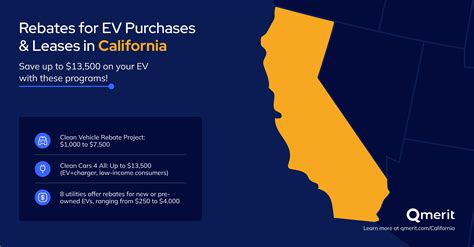Introduction
As the world moves towards sustainable energy solutions, California has taken significant steps to promote the adoption of electric vehicles (EVs). With the aim of reducing emissions, improving air quality, and making electric mobility accessible, the state offers a variety of rebate programs designed to incentivize residents to consider electric vehicles. This article delves into the details of California’s electric vehicle rebate programs, exploring eligibility criteria, benefits, and helpful tips for prospective EV buyers.
Understanding California’s Electric Vehicle Rebate Programs
California Clean Vehicle Rebate Project (CVRP)
The California Clean Vehicle Rebate Project (CVRP) is one of the primary initiatives aimed at encouraging residents to switch to electric vehicles. The program offers rebates for the purchase or lease of new battery electric, plug-in hybrid electric, and fuel cell vehicles. Rebate amounts can vary based on vehicle type and the income level of the applicant.
- Battery Electric Vehicles (BEVs): $2,000 rebate
- Plug-In Hybrid Electric Vehicles (PHEVs): $1,000 rebate
- Fuel Cell Vehicles: $5,000 rebate
Eligibility Criteria
To qualify for the CVRP, applicants must meet certain eligibility requirements:
- Residency in California.
- The vehicle must be purchased or leased from a dealership.
- Gross income limits apply; full rebate amounts are accessible to individuals with an income of $150,000 or less for single filers, $204,000 for head of household, and $300,000 for joint filers.
Income Cap Rebates
California also offers income-based rebates under the CVRP to further assist lower-income residents:
- Low-income applicants may receive up to $4,500 for purchasing a BEV.
- Additional benefits include an increased rebate for used electric vehicles.
Clean Fuel Reward Program
In addition to the CVRP, California provides the Clean Fuel Reward Program, which offers a rebate of up to $750 towards the purchase or lease of a new electric vehicle. Unlike the CVRP, this program is available at the point of sale, making it more accessible and reducing the upfront costs of EVs.
California’s Low-Income Home Energy Assistance Program (LIHEAP)
Households participating in the Low-Income Home Energy Assistance Program may also be eligible for additional incentives and support when considering an electric vehicle. This can include access to funding for charging infrastructure or further rebates.
Tax Incentives and Additional Benefits
California residents purchasing electric vehicles can also take advantage of federal tax credits. While these credits vary based on vehicle specifications, owners may receive up to $7,500 in federal tax rebates. The combination of state and federal incentives can significantly reduce the net cost of an electric vehicle, making the transition to EVs more financially feasible.
How to Apply for Rebates
Applying for California’s EV rebate programs is a straightforward process:
- Choose an eligible electric vehicle from a dealership or make a direct purchase.
- Complete the appropriate application form available on the California Air Resources Board (CARB) website.
- Submit all required documentation, including proof of residency, income verification if applicable, and vehicle purchase documents.
- Once the application is reviewed and approved, you will receive your rebate via check or direct deposit.
Conclusion
Transitioning to an electric vehicle in California comes with a plethora of benefits thanks to comprehensive rebate programs designed to alleviate the financial barriers associated with EV ownership. From the CVRP to the Clean Fuel Reward Program, California is committed to fostering a sustainable and cleaner transportation future. By understanding the various programs available, residents can easily take advantage of the financial incentives, contributing to a greener planet while saving money in the process. Whether you are a long-time EV enthusiast or a first-time buyer, navigating California’s electric vehicle rebate programs can lead you to significant savings and a much clearer conscience.
Frequently Asked Questions (FAQs)
1. How long does it take to receive the rebate after applying?
The processing time for rebates can range from 3 to 12 weeks, depending on the volume of applications received. It’s advisable to keep track of your application status online.
2. Can I combine state and federal rebates?
Yes, California residents can combine state rebates, such as those from the CVRP and the Clean Fuel Reward Program, with federal tax credits for significant savings.
3. Are used electric vehicles eligible for rebates?
Yes, both new and some used electric vehicles can qualify for rebates. However, the application process for used vehicles may differ slightly.
4. What happens if I sell my electric vehicle before the rebate period ends?
If you sell your vehicle within 36 months of receiving a rebate, you may be required to pay back a portion of the rebate, as it is designed for continued ownership.
5. Can I apply for the rebate if I lease a vehicle?
Yes, leasing an eligible electric vehicle qualifies for the CVRP rebate, provided that you meet all other criteria.
This HTML article provides a detailed overview of California’s electric vehicle rebate programs, with clear sections to help readers navigate important aspects of EV incentives. It concludes with a useful FAQ section to address common inquiries.
Download Rebates For Electric Cars California
